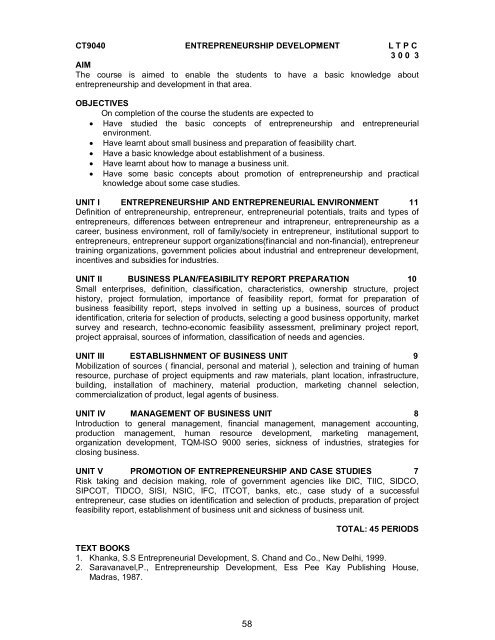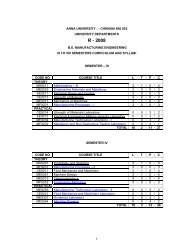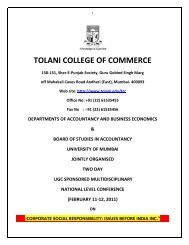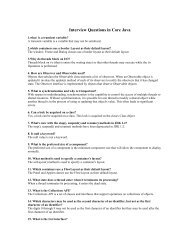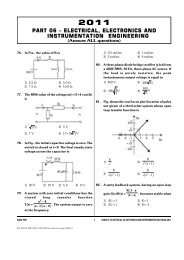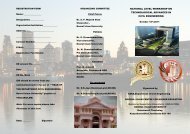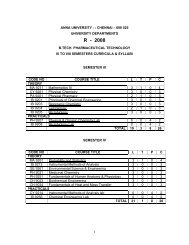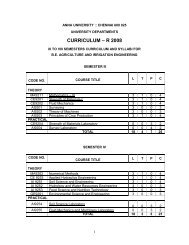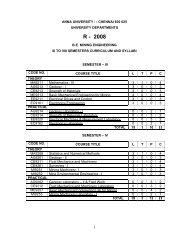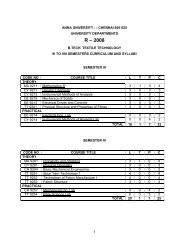b.tech. ceramic technology - Technicalsymposium
b.tech. ceramic technology - Technicalsymposium
b.tech. ceramic technology - Technicalsymposium
You also want an ePaper? Increase the reach of your titles
YUMPU automatically turns print PDFs into web optimized ePapers that Google loves.
CT9040 ENTREPRENEURSHIP DEVELOPMENT L T P C3 0 0 3AIMThe course is aimed to enable the students to have a basic knowledge aboutentrepreneurship and development in that area.OBJECTIVESOn completion of the course the students are expected to Have studied the basic concepts of entrepreneurship and entrepreneurialenvironment. Have learnt about small business and preparation of feasibility chart. Have a basic knowledge about establishment of a business. Have learnt about how to manage a business unit. Have some basic concepts about promotion of entrepreneurship and practicalknowledge about some case studies.UNIT I ENTREPRENEURSHIP AND ENTREPRENEURIAL ENVIRONMENT 11Definition of entrepreneurship, entrepreneur, entrepreneurial potentials, traits and types ofentrepreneurs, differences between entrepreneur and intrapreneur, entrepreneurship as acareer, business environment, roll of family/society in entrepreneur, institutional support toentrepreneurs, entrepreneur support organizations(financial and non-financial), entrepreneurtraining organizations, government policies about industrial and entrepreneur development,incentives and subsidies for industries.UNIT II BUSINESS PLAN/FEASIBILITY REPORT PREPARATION 10Small enterprises, definition, classification, characteristics, ownership structure, projecthistory, project formulation, importance of feasibility report, format for preparation ofbusiness feasibility report, steps involved in setting up a business, sources of productidentification, criteria for selection of products, selecting a good business opportunity, marketsurvey and research, <strong>tech</strong>no-economic feasibility assessment, preliminary project report,project appraisal, sources of information, classification of needs and agencies.UNIT III ESTABLISHNMENT OF BUSINESS UNIT 9Mobilization of sources ( financial, personal and material ), selection and training of humanresource, purchase of project equipments and raw materials, plant location, infrastructure,building, installation of machinery, material production, marketing channel selection,commercialization of product, legal agents of business.UNIT IV MANAGEMENT OF BUSINESS UNIT 8Introduction to general management, financial management, management accounting,production management, human resource development, marketing management,organization development, TQM-ISO 9000 series, sickness of industries, strategies forclosing business.UNIT V PROMOTION OF ENTREPRENEURSHIP AND CASE STUDIES 7Risk taking and decision making, role of government agencies like DIC, TIIC, SIDCO,SIPCOT, TIDCO, SISI, NSIC, IFC, ITCOT, banks, etc., case study of a successfulentrepreneur, case studies on identification and selection of products, preparation of projectfeasibility report, establishment of business unit and sickness of business unit.TOTAL: 45 PERIODSTEXT BOOKS1. Khanka, S.S Entrepreneurial Development, S. Chand and Co., New Delhi, 1999.2. Saravanavel,P., Entrepreneurship Development, Ess Pee Kay Publishing House,Madras, 1987.58


